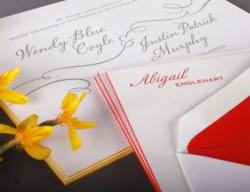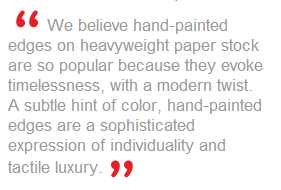 The hand painting of paper edges is enjoying a renewed appreciation among modern consumers of fine stationery and invitations. In response to this trend, William Arthur, Inc. has introduced a line of stationery featuring custom, hand-painted edges on business, calling and correspondence cards, as well as on wedding and event invitations.
The hand painting of paper edges is enjoying a renewed appreciation among modern consumers of fine stationery and invitations. In response to this trend, William Arthur, Inc. has introduced a line of stationery featuring custom, hand-painted edges on business, calling and correspondence cards, as well as on wedding and event invitations.
“What’s old is new again,” observes Lisa Blinn, Vice President of Design and Marketing for the luxury brand. “We specialize in unique, custom printing for the discerning customer. In recent years we’ve observed a growing appreciation for fine printing and artisanal papers. Offering hand-painted edges to our customers is an exciting addition to our line.”
“As media in our culture become increasingly digitized, time-honored print methods such as letterpress and engraving serve as an antidote.” Blinn continues. “There’s a renewed appreciation of fine craftsmanship. Hand-painted edges on invitations, business and correspondence cards is another example of consumers seeking a richer, more tactile connection when they communicate and express their identities.”
Painting the edges of paper began as a bookbinding practice in the 13th century as a way to help preserve the edges of book pages. Later, in the 18th century, the edges of devotional books were painted red. The edging process evolved into a rise in popularity of gilt-edged books in the 19th and 20th centuries as a sign of status. Hand-painted edges have enjoyed resurgence in recent years in the wedding and fine stationery milieu, especially among younger consumers.
“Color and paper quality are driving elements for wedding invitation consumers especially,” notes Blinn. “We believe hand-painted edges on heavyweight paper stock are so popular because they evoke timelessness, with a modern twist. A subtle hint of color, hand-painted edges are a sophisticated expression of individuality and tactile luxury.”
